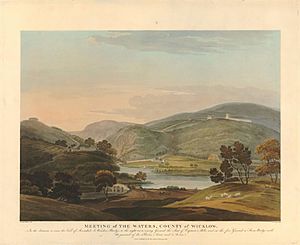Abraham Mills (geologist) facts for kids
Abraham Mills (born around 1750 – died March 2, 1828) was an English manager for mining companies and a geologist. He helped run important copper businesses and studied rocks and minerals.
Life and Work
Abraham Mills grew up near Exeter in Devon, England. In 1783, he was renting land in Gerston, also in Devon. His brother, Henry Mills, worked as a timber merchant.
A company called Roe & Co., which smelted (melted down) copper, hired Mills. They needed a new manager for their works in Macclesfield.
In 1785, Roe & Co. lost their lease for a big copper mine in Anglesey, Wales. This meant they needed new sources of copper. So, they bought old copper mines in County Wicklow, Ireland. From 1787, Mills started working at the Cronebane copper mines in Wicklow with Thomas Weaver.
Later, gold was found in the same area in 1795. Mills and Weaver were the ones who told the government about this exciting discovery. Mills also wrote scientific papers about the gold.
During the Irish Rebellion of 1798, Abraham Mills served as a captain in the Cronebane Infantry, acting as a militia commander. In late 1798, the mines were put under the management of Mills and Thomas Weaver (the younger).
Mills also played a big part in moving Roe & Co.'s copper smelter. It was moved from Toxteth to a new location on the River Neath in South Wales. He helped set up everything for the move.
In 1799, Mills gave information to a special meeting of the House of Commons about the copper trade. Also in 1799, a bank called Hawkins & Mills closed down. This bank had been the first in Macclesfield, opening in 1787. Mills was one of the founders, but he wasn't actively involved in running it day-to-day.
Abraham Mills was a very respected scientist. He was a Fellow of the Royal Society, which is a group of top scientists. He was also on the Chemistry and Mineralogy Committee of the Dublin Society.
Around 1810, Mills started to feel that Roe & Co. might not do well in the future. The company eventually closed down around 1817. He later worked for the Ordnance Department in Dublin.
Abraham Mills passed away on March 2, 1828, in Bodlendeb, Caernarvonshire, Wales. He was 78 years old. He was buried on March 8, 1828, in Conway, Wales. He had one child, a daughter named Mary Anne.
Geological Discoveries
Abraham Mills was very interested in geology, the study of Earth's rocks and how they are formed. In 1789, he wrote to another scientist, Richard Kirwan, to suggest corrections to a paper about English coal mines. He used the Blakelow pit in Macclesfield as an example. Kirwan was impressed and had Mills's letter read to the Royal Irish Academy.
Mills also visited Islay, an island where Roe & Co. had a mine that had just closed. This visit led him to write a paper in 1790 called Observations on the Whyn Dykes of Ilay. In this paper, Mills suggested that certain rock formations, known as "whin dykes," were formed by volcanoes.
Another scientist, John Lloyd, disagreed with him. So, Mills published another paper in 1790 called On the Strata and Volcanic Appearances in the North of Ireland and Western Islands of Scotland. In the big scientific discussions of that time, this paper showed that Mills believed in the "igneous theory." This theory states that rocks like granite and basalt are formed from molten rock (magma or lava). A famous geologist named James Hutton even mentioned Mills's work in his own important book, Theory of the Earth.
Mills also wrote:
- A mineralogical account of the native gold lately discovered in Ireland (1796) – This was about the gold found in Ireland that he helped report.
See also


